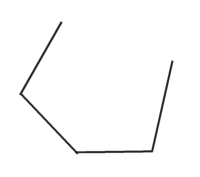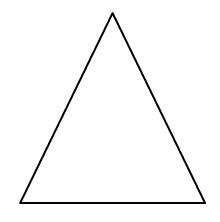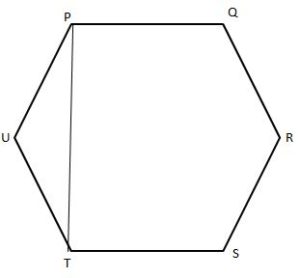Question 1. Which of the following are polygons? Give reasons.
(i)  (ii)
(ii)  (iii)
(iii) 
Solution:
From the given images,
(i) The first image is not a closed figure. So, it is not a polygon.
(ii) The Second image is a closed figure connecting with line segments. Therefore, the image is a polygon.
(iii) Also, the third image is a closed figure connecting with line segments. Therefore, the image is a polygon.
Question 2. How many diagonals do the below polygons have?
(a) Octagon
(b) Triangle
(c) Regular Hexagon
(d) Quadrilateral
(e) Pentagon
(f) Convex quadrilateral
Solution:
(a) Given polygon is Octagon.
The Octagon consists of 8 sides.
The formula to find the diagonal of the Octagon is n(n-3)/2 where n is the number of sides of the polygon.
Here n = 8.
Substitute 8 in the n(n-3)/2
n(n-3)/2 = 8(8 – 3)/2 = 8(5)/2 = 40/2 = 20.
Therefore, the number of diagonals in the octagon has 20.
(b) Given polygon is Triangle.
The Triangle consists of 3 sides or 3 line segments.
The formula to find the diagonal of the Triangle is n(n-3)/2 where n is the number of sides of the polygon.
Here n = 3.
Substitute 3 in the n(n-3)/2
n(n-3)/2 = 3(3 – 3)/2 = 3(0)/2 = 0.
Therefore, the number of diagonals in the Triangle is 0.
(c) Given polygon is Regular Hexagon.
The Regular Hexagon consists of 6 sides or 6 line segments.
The formula to find the diagonal of the Regular Hexagon is n(n-3)/2 where n is the number of sides of the polygon.
Here n = 6.
Substitute 6 in the n(n-3)/2
n(n-3)/2 = 6(6 – 3)/2 = 6(3)/2 = 9.
Therefore, the number of diagonals in the Regular Hexagon is 9.
(d) Given polygon is Quadrilateral.
The Quadrilateral consists of 4 sides or 4 line segments.
The formula to find the diagonal of the Quadrilateral is n(n-3)/2 where n is the number of sides of the polygon.
Here n = 4.
Substitute 4 in the n(n-3)/2
n(n-3)/2 = 4(4 – 3)/2 = 4(1)/2 = 2.
Therefore, the number of diagonals in the Quadrilateral is 2.
(e) Given polygon is Pentagon.
The Pentagon consists of 5 sides or 5 line segments.
The formula to find the diagonal of the Pentagon is n(n-3)/2 where n is the number of sides of the polygon.
Here n = 5.
Substitute 5 in the n(n-3)/2
n(n-3)/2 = 5(5 – 3)/2 = 5(2)/2 = 5.
Therefore, the number of diagonals in the Pentagon is 5.
(f) Given polygon is Convex quadrilateral.
The Convex quadrilateral consists of 4 sides or 4 line segments.
The formula to find the diagonal of the Convex quadrilateral is n(n-3)/2 where n is the number of sides of the polygon.
Here n = 4.
Substitute 4 in the n(n-3)/2
n(n-3)/2 = 4(4 – 3)/2 = 4(1)/2 = 2.
Therefore, the number of diagonals in the Convex quadrilateral is 2.
Question 3. Draw a regular hexagon. Join any three of its vertices and draw a triangle. Name the triangle obtained.
Solution:
The regular hexagon is

The vertices of the hexagon are P, Q, R, S, T, and U. By joining the vertices P and T, we can get a triangle of PUT.
The name of the triangle is PUT.
Question 4. What is a regular polygon? Write the names of regular polygons having
(a) 4 sides
(b) 3 sides
(c) 6 sides
Solution:
Regular Polygon: The regular polygon consists of all equal sides and also equal angles in it. The regular polygon has three parts. They are sides, vertices, and angles (interior and exterior).
(a) The regular polygon consists of 4 sides are quadrilaterals. The quadrilaterals are closed shapes with 4 sides. Some of the quadrilaterals are
(i) square
(ii) rectangle
(iii) parallelogram
(iv) rhombus
(v) trapezium
(vi) isosceles trapezium
(vii) kite
(viii) irregular quadrilateral
(b) The regular polygon consists of 3 sides are Triangles. The Triangles are closed shapes with 3 sides. Some of the Triangles are
(i) Equilateral
(ii) Isosceles
(iii) Scalene
(c) The regular polygon consists of 6 sides are hexagon. The hexagons are closed shapes with 6 sides.
Question 5. What can you say about the angle sum property of a convex polygon having:
(a) 6 sides
(b) 5 sides
(c) 9 sides
(d) 10 sides
Solution:
(a) Method 1: Given that the sides of the convex polygon are 6.
The total number of triangles formed by the 6 sides of a convex polygon is 6.
The sum of the angles of a triangle is equal to 180°.
It can also be written as 6 × 180° = 1080 degrees.
As we know that the angle around a point is 360∘.
The total sum of interior angle can find out by subtracting 360 degrees from 1080 degrees.
= 1080 – 360 = 720 degress.
Therefore, the angle sum of a polygon with 6 sides is 720°.
Method 2: We can use the formula to find the sum of the interior angles of a polygon is 180°(n − 2). Here n is the total number of sides.
So, n = 6.
180°(6 – 2) = 180°(4) = 720°.
(b) Given that the sides of the convex polygon are 5.
The total number of triangles formed by the 5 sides of the convex polygon is 5.
The sum of the angles of a triangle is equal to 180°.
It can also be written as 5 × 180° = 900 degrees.
As we know that the angle around a point is 360∘.
The total sum of interior angles can find out by subtracting 360 degrees from 900 degrees.
= 900 – 360 = 540 degress.
Therefore, the angle sum of a polygon with 5 sides is 540°.
(c) Given that the sides of the convex polygon are 9.
The total number of triangles formed by the 9 sides of the convex polygon is 9.
The sum of the angles of a triangle is equal to 180°.
It can also be written as 9 × 180° = 1620 degrees.
As we know that the angle around a point is 360∘.
The total sum of interior angles can find out by subtracting 360 degrees from 1620 degrees.
= 1620 – 360 = 1260 degress.
Therefore, the angle sum of a polygon with 9 sides is 1260°.
(d) Given that the sides of the convex polygon are 10.
The total number of triangles formed by the 10 sides of the convex polygon is 10.
The sum of the angles of a triangle is equal to 180°.
It can also be written as 10 × 180° = 1800 degrees.
As we know that the angle around a point is 360∘.
The total sum of interior angles can find out by subtracting 360 degrees from 1800 degrees.
= 1800 – 360 = 1440 degress.
Therefore, the angle sum of a polygon with 10 sides is 1440°.
Question 6.